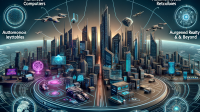The world is constantly evolving, and with it, technology is advancing at an unprecedented rate. One of the most significant advancements in recent years is the development of Artificial Intelligence (AI). AI has the potential to revolutionize the way businesses operate on a global scale. From streamlining processes to improving efficiency, the impact of AI on global business operations is immense.
Thank you for reading this post, don't forget to subscribe!One of the most significant advantages of AI is its ability to automate tasks that were previously done by humans. This not only saves time but also reduces the risk of human error. With AI, businesses can now process large amounts of data in a fraction of the time it would take a human to do so. This has led to increased efficiency and productivity, allowing businesses to focus on more critical tasks.
Moreover, AI has the potential to improve decision-making processes. With the help of machine learning algorithms, AI can analyze vast amounts of data and provide valuable insights. This enables businesses to make data-driven decisions, leading to better outcomes. For example, in the healthcare industry, AI can analyze patient data and assist doctors in making accurate diagnoses and treatment plans. This not only improves patient care but also reduces the risk of misdiagnosis.
Another significant impact of AI on global business operations is its ability to personalize customer experiences. With the help of AI, businesses can gather and analyze customer data to understand their preferences and behavior. This allows them to tailor their products and services to meet the specific needs of their customers. As a result, businesses can build stronger relationships with their customers, leading to increased customer satisfaction and loyalty.
Furthermore, AI has the potential to improve supply chain management. With the use of AI-powered systems, businesses can track inventory levels, predict demand, and optimize logistics. This not only reduces costs but also ensures that products are delivered to customers in a timely and efficient manner. In addition, AI can also help identify potential risks and disruptions in the supply chain, allowing businesses to take proactive measures to mitigate them.
The impact of AI on global business operations is not limited to large corporations. Small and medium-sized enterprises (SMEs) can also benefit from this technology. With the availability of affordable AI tools and platforms, SMEs can now access the same level of technology as larger companies. This allows them to compete on a global scale and expand their reach.
Moreover, AI has the potential to create new job opportunities. While there are concerns about AI replacing human jobs, it is also creating new roles that require human skills such as critical thinking, problem-solving, and creativity. As AI takes over mundane and repetitive tasks, humans can focus on more complex and meaningful work. This not only improves job satisfaction but also leads to a more skilled and productive workforce.
The impact of AI on global business operations is not without its challenges. One of the main concerns is the ethical use of AI. As AI becomes more advanced, there is a need for regulations and guidelines to ensure that it is used responsibly. This includes addressing issues such as data privacy, bias, and transparency.
In conclusion, the impact of AI on global business operations is significant and far-reaching. From automating tasks to improving decision-making processes, AI has the potential to transform the way businesses operate. While there are challenges that need to be addressed, the benefits of AI far outweigh them. As we continue to advance in technology, the future looks bright for businesses that embrace AI and use it to their advantage.
The Rise of Blockchain Technology and Its Potential for Global Disruption
The world is constantly evolving, and with it, technology is advancing at an unprecedented rate. From smartphones to artificial intelligence, we have seen remarkable innovations that have transformed the way we live and work. However, one technology that has been gaining significant attention in recent years is blockchain. This revolutionary technology has the potential to disrupt various industries and change the way we conduct transactions globally.
So, what exactly is blockchain? In simple terms, it is a decentralized digital ledger that records transactions across a network of computers. Each transaction is recorded as a block, and once verified, it is added to the chain of blocks, creating a permanent and unalterable record. This technology was initially developed to support the digital currency, Bitcoin, but its potential goes far beyond that.
One of the main advantages of blockchain technology is its decentralized nature. Unlike traditional systems where a central authority controls and verifies transactions, blockchain operates on a peer-to-peer network. This means that there is no single point of failure, making it more secure and less vulnerable to cyber attacks. Additionally, the use of cryptography ensures that the data stored on the blockchain is tamper-proof, providing a high level of trust and transparency.
The potential of blockchain technology for global disruption lies in its ability to streamline and simplify processes. With its decentralized and secure nature, it has the potential to eliminate intermediaries and reduce transaction costs significantly. This could have a massive impact on industries such as finance, supply chain management, and even government services.
In the financial sector, blockchain technology has the potential to revolutionize the way we conduct transactions. With traditional banking systems, international transactions can take days to process, and the fees involved can be exorbitant. However, with blockchain, these transactions can be completed in a matter of minutes, and at a fraction of the cost. This could have a significant impact on global trade and commerce, making it more efficient and accessible for businesses of all sizes.
Another industry that could see a major disruption from blockchain technology is supply chain management. With the ability to track and record every step of a product’s journey, blockchain can provide a transparent and secure way to manage supply chains. This could help eliminate issues such as counterfeit products and ensure that products are ethically sourced. It could also improve efficiency and reduce costs for businesses, ultimately benefiting consumers.
Governments around the world are also exploring the potential of blockchain technology. With its decentralized nature, it has the potential to improve transparency and reduce corruption in government services. For instance, blockchain-based voting systems could eliminate the possibility of electoral fraud, ensuring fair and accurate elections. It could also improve the efficiency of government services, such as land registry and identity verification.
The potential of blockchain technology for global disruption is vast, and we are only scratching the surface of its capabilities. As more industries and businesses adopt this technology, we can expect to see significant changes in the way we conduct transactions and manage data. However, like any new technology, there are challenges that need to be addressed, such as scalability and regulatory frameworks. But with the rapid pace of development and innovation in this field, these challenges are being tackled, and we can expect to see even more advancements in the near future.
In conclusion, the rise of blockchain technology has the potential to disrupt various industries and change the way we conduct transactions globally. Its decentralized and secure nature, along with its ability to streamline processes, make it a powerful tool for businesses and governments alike. As we continue to advance in this digital age, it is exciting to see how blockchain technology will shape our future and create a more connected and efficient world.
The Role of Virtual and Augmented Reality in Advancing Global Education
Technology has been rapidly advancing in recent years, and its impact can be seen in almost every aspect of our lives. From communication to entertainment, technology has revolutionized the way we live and work. One area where technology has made significant strides is in education. With the rise of virtual and augmented reality, the possibilities for global education have expanded exponentially.
Virtual and augmented reality, or VR and AR, are immersive technologies that allow users to experience a simulated environment. While VR creates a completely virtual world, AR overlays digital elements onto the real world. These technologies have been primarily used in the gaming and entertainment industries, but their potential for education is now being recognized.
One of the main advantages of VR and AR in education is their ability to provide a hands-on learning experience. Traditional education methods often rely on textbooks and lectures, which can be dry and unengaging for students. With VR and AR, students can interact with the subject matter in a more dynamic and engaging way. For example, students can explore ancient civilizations in VR, or dissect a virtual frog in AR, providing a more immersive and memorable learning experience.
Moreover, VR and AR have the potential to break down geographical barriers and bring global education to students. With these technologies, students can visit different countries and cultures without leaving their classroom. This opens up a world of possibilities for students who may not have the means to travel or access to resources for learning about different cultures. It also allows for a more diverse and inclusive learning experience, as students from different backgrounds can come together and learn from each other.
In addition to cultural education, VR and AR can also enhance language learning. With VR, students can be fully immersed in a language, allowing for a more natural and effective learning experience. They can practice speaking and listening in a simulated environment, which can help build confidence and fluency. AR can also be used to overlay translations onto real-world objects, making it easier for students to learn new vocabulary.
Another area where VR and AR can advance global education is in the field of science and technology. These technologies can provide a safe and controlled environment for students to conduct experiments and simulations. This is especially beneficial for students in developing countries who may not have access to expensive laboratory equipment. With VR and AR, students can learn and experiment in a virtual lab, providing them with the necessary skills and knowledge for future careers in science and technology.
Furthermore, VR and AR can also play a crucial role in special education. These technologies can provide a more inclusive learning experience for students with disabilities. For example, students with visual impairments can use VR to experience a virtual world and learn about different environments. AR can also be used to provide real-time translations for students with hearing impairments, making it easier for them to participate in classroom discussions.
The potential for VR and AR in global education is vast, and its impact is already being seen in various educational institutions around the world. However, there are still challenges that need to be addressed, such as the cost of implementing these technologies and the need for proper training for teachers. But with the rapid advancement of technology, these challenges can be overcome, and the benefits of VR and AR in education will continue to grow.
In conclusion, virtual and augmented reality have the potential to advance global education in ways that were previously unimaginable. These technologies can provide a more engaging, inclusive, and hands-on learning experience for students, breaking down geographical and cultural barriers. As technology continues to advance, the possibilities for global education are endless, and we can look forward to a more connected and knowledgeable world.
The Future of Transportation: How Autonomous Vehicles are Revolutionizing Global Mobility
The world of transportation is rapidly evolving, and one of the most exciting developments is the rise of autonomous vehicles. These self-driving cars, trucks, and buses are set to revolutionize global mobility in ways we never thought possible. With advanced technology and innovative engineering, autonomous vehicles are paving the way for a more efficient, safe, and sustainable future.
One of the main advantages of autonomous vehicles is their potential to reduce accidents and fatalities on the road. According to the World Health Organization, over 1.35 million people die each year in road traffic accidents. With autonomous vehicles, this number could significantly decrease as they eliminate human error, which is responsible for 94% of all accidents. These vehicles use a combination of sensors, cameras, and artificial intelligence to navigate the roads, making split-second decisions that humans may not be able to make in time. This technology has the potential to save countless lives and make our roads safer for everyone.
In addition to safety, autonomous vehicles also have the potential to greatly improve traffic flow and reduce congestion. With the ability to communicate with each other and adjust their speed and routes accordingly, these vehicles can optimize traffic patterns and reduce the time spent in traffic. This not only saves time for commuters but also reduces carbon emissions from idling vehicles. In fact, a study by the University of Michigan found that a fleet of connected and autonomous vehicles could reduce traffic congestion by up to 75%.
Moreover, autonomous vehicles have the potential to greatly improve accessibility for individuals with disabilities or limited mobility. With self-driving cars, these individuals will have the freedom to travel independently, without relying on public transportation or specialized services. This will greatly enhance their quality of life and provide them with more opportunities for work, education, and social activities.
The impact of autonomous vehicles goes beyond just personal transportation. These vehicles also have the potential to revolutionize the transportation of goods and services. With self-driving trucks, the delivery of goods can be more efficient and cost-effective. These vehicles can operate 24/7, without the need for breaks or rest, and can optimize their routes to reduce delivery times. This will not only benefit businesses but also consumers who will receive their goods faster and at a lower cost.
Furthermore, the rise of autonomous vehicles will also have a significant impact on the environment. With the use of electric and hybrid technology, these vehicles will greatly reduce carbon emissions and contribute to a more sustainable future. In addition, the optimization of traffic flow and reduction of congestion will also lead to a decrease in air pollution. This is especially important in urban areas where air quality is a major concern.
While there are many benefits to autonomous vehicles, there are also some challenges that need to be addressed. One of the main concerns is the potential loss of jobs in the transportation industry. However, with the rise of autonomous vehicles, there will also be a need for new jobs in areas such as software development, maintenance, and monitoring of these vehicles. It is important for governments and industries to work together to ensure a smooth transition and provide support for those who may be affected by these changes.
In conclusion, the future of transportation is looking bright with the advancement of autonomous vehicles. These vehicles have the potential to greatly improve safety, reduce congestion, enhance accessibility, and contribute to a more sustainable future. While there are challenges that need to be addressed, the benefits far outweigh them. With continued research and development, we can look forward to a world where autonomous vehicles are the norm, and global mobility is revolutionized for the better.









